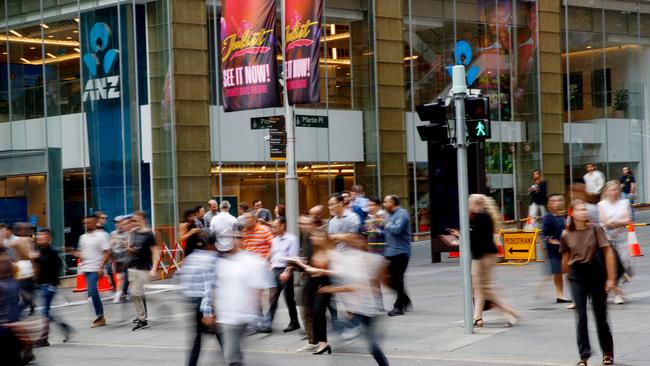The future is hybrid: Why WFH is a win for Aussies and how it’s saving businesses money
Far from fading, hybrid work is thriving – saving time, cutting costs, and offering a major competitive edge to businesses willing to adapt.

Hybrid working will remain a permanent feature of Australia’s labour market, with the rate of workers returning to full-time office work stalling — with the work-from-home model proving highly profitable for companies willing to embrace it.
Australia is now among the global leaders in hybrid work adoption, with levels stubbornly remaining higher than before the pandemic, despite efforts by some employers to force staff back into the office.
Speaking at a Committee for Economic Development of Australia (CEDA) event on Tuesday, Stanford University Professor Nick Bloom said work-from-home rates had stabilised across English-speaking countries, including Australia, with hybrid arrangements firmly taking hold.
“The big picture I want to tell you is, one, work from home has kind of stabilised. There has not been a return to the office,” Professor Bloom said. “The reason it’s there is hybrid has turned out to be very profitable for firms.”
Research shows that 80 per cent of Fortune 500 companies have committed to hybrid models after trials showed no loss in productivity and a 35 per cent drop in staff turnover, cutting recruitment costs and improving retention.
A new CEDA report reveals that Australians working from home since the pandemic are saving an average of 3.4 hours a week on commuting, translating to an annual time and cost saving of $5308.
The research also shows a 4.4 per cent rise in workforce participation, with remote workers often clocking nearly 20 per cent more hours. This shift has particularly benefited groups previously hindered by on-site work, such as parents and those with health conditions.

Professor Bloom said hybrid working would stay in Australia because it made financial sense. A landmark six-month randomised control trial involving 1600 employees at travel giant Trip.com found no decline in productivity when staff worked two days remotely each week, but quit rates fell by 35 per cent.
“Every person that quits costs us about $50,000 because we’ve got to go out, readvertise, reinterview, retrain, re-get up to speed,” he said. “Hybrid is phenomenally profitable.”
Several high-profile businesses have forced workers back into the office in the past year, including Tesla and Amazon in the US, while in Australia, Tabcorp and the NSW government have also ended flexible arrangements.
Opposition leader Peter Dutton has vowed that under a Coalition government public servants would be forced back into the office five days a week. He later back flipped
as the gap between worker and employer expectations continues to widen.
Professor Bloom warned that companies failing to manage hybrid work well risk losing employees to firms that offer better flexibility. Poorly executed policies — such as those without co-ordinated in-office days — could drive chief executives to abandon hybrid altogether.
“A good law is an easy-to-enforce law,” he said. “Set a sensible plan — maybe three days in the office, co-ordinate on fixed days, and then stick to it.”
CSIRO chair Ming Long, speaking at the same event, said hybrid work was crucial for building operational resilience in an era of climate disruption, pandemics and other shocks.
“I want to have that level of resilience in the organisation to adapt to whatever catastrophe or whatever thing is going to disrupt the organisation,” Ms Long said. “That muscle needs to exist well into the future.”
She said organisational culture would be critical in ensuring teams could switch rapidly between home and office in the face of unexpected disruptions.
“If you’re always just working in the office, then the level of resilience in the organisation to adapt to whatever catastrophe or whatever thing is going to disrupt the organisation will disappear. That muscle needs to exist, and it needs to exist into the future,” Ms Long said.
The rise of remote work has also had profound impacts on cities and real estate markets.

Professor Bloom said spending and populations had shifted to the suburbs, while central business districts remained less populated than before the pandemic.
“People moved out of city centres into the suburbs,” he said. “Traffic patterns are better. Sandwich shop demand is down in the city centre but way up in the suburbs.”
While office occupancy is sitting at about 60 per cent of pre-pandemic levels, Professor Bloom said the narrative of a commercial real estate collapse was overblown.
“It turns out that those three days tend to be Tuesday, Wednesday, Thursday, and it’s actually very hard to share offices,” he said.
Professor Bloom said about 20 per cent of workers never wanted to work from home — typically younger employees who valued social connection — while about 30 per cent wanted to work remotely full-time, usually older workers with young families.
“There’s no one-size-fits-all,” he said. “As long as you stick with it as a company … over time your employees are going to adjust.”
Ms Long said leaders who failed to adapt their management styles for hybrid workforces would be left behind.
“If you do not know, as a leader, how to lead in hybrid, then maybe you are not the leader for the organisations of the future,” she said.
More Coverage
Originally published as The future is hybrid: Why WFH is a win for Aussies and how it’s saving businesses money





